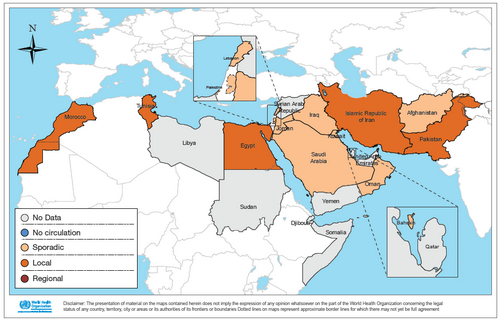In the WHO Eastern Mediterranean Region, influenza activity decreased in the month of January 2018 in many countries reporting data to FluNet and EMFLU namely, Afghanistan, Bahrain, Egypt, Iran (Islamic Republic of), Iraq, Jordan, Kuwait, Lebanon, Morocco, occupied Palestinian territory (oPt), Pakistan, Saudi Arabia, and Tunisia (Fig. 1). All seasonal influenza subtypes were detected in the Region.

Fig. 1. Influenza geographic spread in the Eastern Mediterranean Region, January 2018
Influenza activity by sub-type
- In January 2018, no new cases of human influenza A(H5N1) were reported in Egypt, however avian A(H5N8) have been confirmed in Afghanistan, Iraq, Iran and Saudi Arabia in poultry and wild birds with no reported cases among humans.
- In the northern Africa influenza transmission zone, Morocco and Egypt reported co-circulation of influenza A(H1N1)pdm09, A(H3N2) and influenza B while Tunisia reported predominant circulation of influenza A(H1N1)pdm09.
- In the Western Asia influenza transmission zone, influenza A(H1N1)pdm09 were detected predominantly with influenza B virus in Jordan, oPt and Iraq while Bahrain, Kuwait, Lebanon and Saudi Arabia reported co-circulation of influenza A(H1N1)pdm09 with A(H3N2) and influenza B virus.
- In southern Asia transmission zone, Afghanistan and Pakistan reported predominant circulation of influenza A(H1N1)pdm09 virus with influenza A(H3N2) while Iran (Islamic Republic of) reported co-circulation of all seasonal influenza viruses.
Fig. 2 shows the weekly distribution of influenza subtypes.

Fig. 2. Weekly positive cases of influenza by subtype, Epi week 4/2017–2018
Circulating influenza viruses by subtype
During January 2018, regional national influenza centres and influenza laboratories tested a total of 10 298 specimens for influenza viruses of which 2402 tested positive (23%).
The average percentage of positivity rates is 24%, with highest positivity rate recorded in Bahrain, Iraq, Jordan, Morocco, Pakistan and Tunisia.
Of the viruses tested, 1708 (71%) were influenza A viruses, including 1248 (52%) influenza /H1N1pdm09 viruses and 416 (17%) were influenza A/H3 viruses; 694 (29%) were influenza B viruses (Fig. 3).

Fig. 3. Circulating influenza viruses in the Region by subtype, Epi week 1–4, 2018
Related link
Influenza monthly update, January 2018


